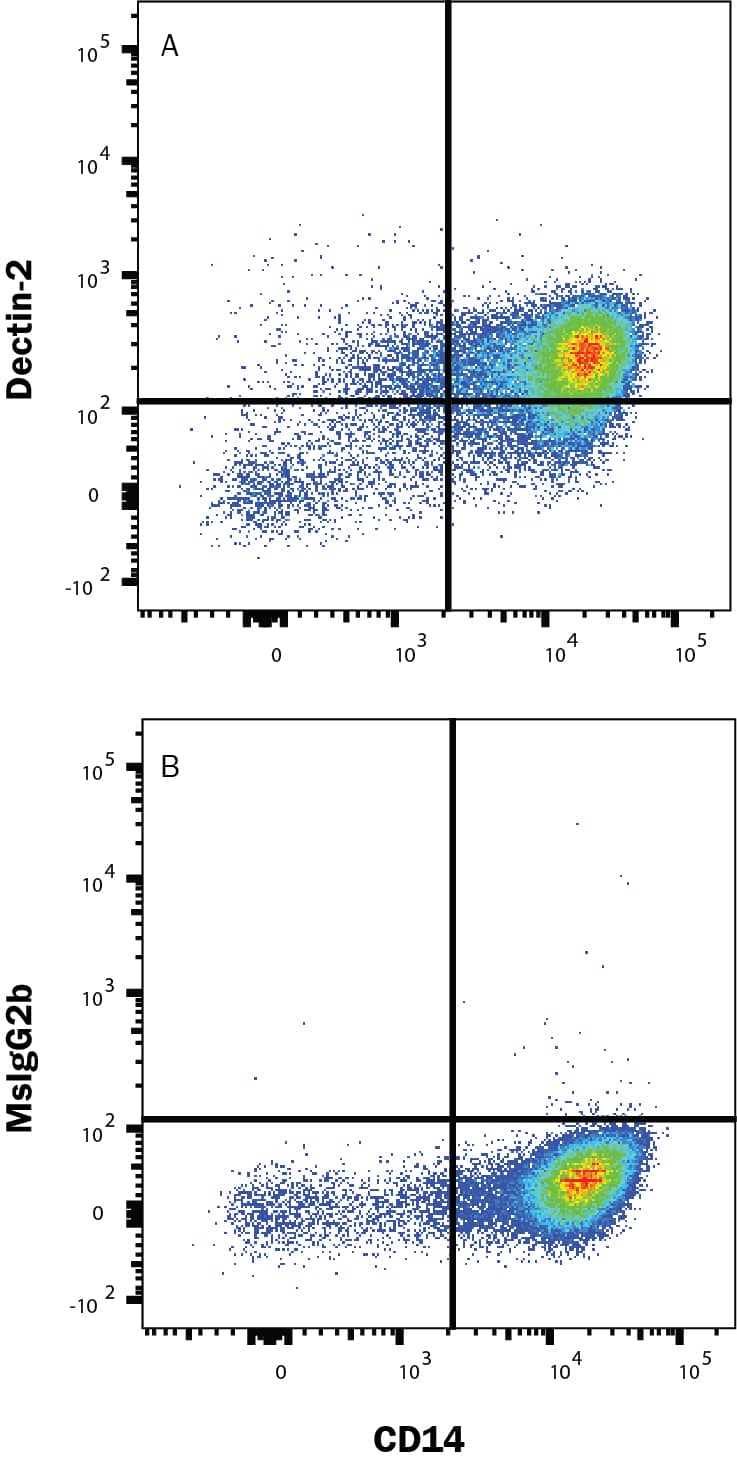Human Dectin-2/CLEC6A Antibody
R&D Systems, part of Bio-Techne | Catalog # MAB31141


Key Product Details
Species Reactivity
Applications
Label
Antibody Source
Product Specifications
Immunogen
Thr46-Leu209
Accession # Q6EIG7
Specificity
Clonality
Host
Isotype
Scientific Data Images for Human Dectin-2/CLEC6A Antibody
Detection of Dectin‑2/CLEC6A in Human PBMC Monocytes by Flow Cytometry.
Human peripheral blood mononuclear cell (PBMC) monocytes were stained with (A) Mouse Anti-Human Dectin-2/CLEC6A Monoclonal Antibody (Catalog # MAB31141) or (B) Mouse IgG2b Isotype Control (Catalog # MAB0041) followed by anti-Mouse IgG PE-conjugated secondary antibody (Catalog # F0102B) and Mouse Anti-Human CD14 APC-conjugated Monoclonal Antibody (Catalog # FAB3832A). View our protocol for Staining Membrane-associated Proteins.Applications for Human Dectin-2/CLEC6A Antibody
CyTOF-ready
Flow Cytometry
Sample: Human PBMC monocytes
Formulation, Preparation, and Storage
Purification
Reconstitution
Formulation
Shipping
Stability & Storage
- 12 months from date of receipt, -20 to -70 °C as supplied.
- 1 month, 2 to 8 °C under sterile conditions after reconstitution.
- 6 months, -20 to -70 °C under sterile conditions after reconstitution.
Background: Dectin-2/CLEC6A
Dectin-2, also known as CLEC6A, CLECSF10, and NKCL, belongs to the C-type lectin family of transmembrane immune regulatory glycoproteins. Dectin-2, plus CLEC4A-E constitute a subgroup of molecules that exhibit approximately 40% amino acid (aa) sequence identity in their extracellular domains (ECD), and have a conserved cysteine spacing in their carbohydrate recognition domains (CRD) (1, 2). Mature human Dectin-2 is a type II transmembrane protein with a short cytoplasmic tail, a transmembrane segment, and a 168 aa ECD with a stalk region and one CRD (3, 4). Within the ECD, human Dectin-2 shares 71% and 75% aa sequence identity with bovine and mouse Dectin-2, respectively. An alternately spliced beta isoform has a deletion of portions of the transmembrane and cytoplasmic regions (5). Full length Dectin-2 is a 27 kDa molecule that is expressed on monocytes, tissue macrophages, and activated CD4+ T cells (4‑6). The CRD of Dectin-2 contains an EPN motif which is characteristic of calcium-dependent mannose-binding lectins. Dectin-2 selectively interacts with high mannose structures in the Man9GlcNAc2 configuration (7). It mediates the recognition of a variety of microorganisms, particularly the filamentous forms of yeast and fungii (7, 8). The short cytoplasmic tail does not contain signaling motifs but mediates association with the ITAM-containing Fc receptor gamma subunit on macrophages (8). Ligation of Dectin-2 induces tyrosine phosphorylation of the gamma subunit, activation of NF kappaB, and enhanced release of TNF-alpha and IL-1ra (8). Macrophage Dectin-2 is up‑regulated in vivo by inflammatory stimuli and UV-B irradiation (5, 6, 9). Dectin-2 is known to participate in UV-induced immunosuppression by interacting with CD4+CD25+ regulatory T cells, which then induce dendritic cells to release IL-4, IL-10, and TGF-beta (10).
References
- Kanazawa, N. (2007) J. Dermatol. Sci. 45:77.
- Kanazawa, N. et al. (2004) Immunobiology 209:179.
- Flornes, L.M. et al. (2004) Immunogenetics 56:506.
- Kanazawa, N. et al. (2004) J. Invest. Dermatol. 122:1522.
- Gavino, A.C. et al. (2005) Exp. Dermatol. 14:281.
- Taylor, P.R. et al. (2005) Eur. J. Immunol. 35:2163.
- McGreal, E.P. et al. (2006) Glycobiology 16:422.
- Sato, K. et al. (2006) J. Biol. Chem. 281:38854.
- Bonkobara, M. et al. (2005) Photochem. Photobiol. 81:944.
- Aragane, Y. et al. (2003) J. Immunol. 171:3801.
Alternate Names
Gene Symbol
UniProt
Additional Dectin-2/CLEC6A Products
Product Documents for Human Dectin-2/CLEC6A Antibody
Product Specific Notices for Human Dectin-2/CLEC6A Antibody
For research use only